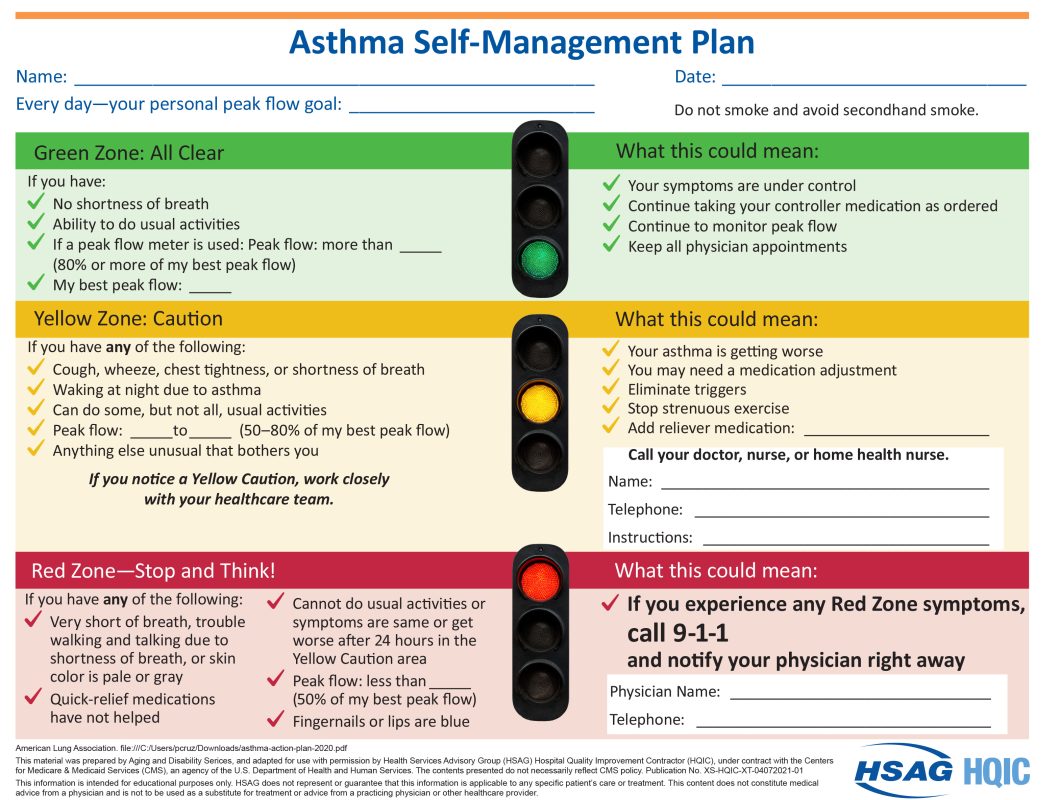When everyone follows the same plan, asthma gets quieter, safer, and less scary. Use this guide to understand the Green, Yellow, and Red Zones, know what to do in each, and keep the right tools ready at home, work, school, and during visits.

What to Set Up First
- Write key contacts: your primary doctor, after-hours line, pharmacy, and nearest emergency department.
- List your medicines: daily controller(s), quick-relief (rescue) inhaler or nebulizer, and oral steroid instructions (if prescribed).
- Peak flow (if used): record your personal best and the cutoff numbers for each zone on your plan.
- Lifestyle note: don’t smoke and avoid secondhand smoke—this is part of daily asthma control. zonetool_asthma_hqic
The Three Zones (and What to Do)
✅ Green Zone — “All Clear”
How it feels
- No shortness of breath, no wheeze, no chest tightness
- Sleeping through the night, doing usual activities
- If using peak flow: ≥80% of personal best
What it means / what to do
- Asthma is controlled.
- Keep taking your controller medicine exactly as ordered, monitor symptoms/peak flow, and keep all scheduled appointments. zonetool_asthma_hqic
⚠️ Yellow Zone — “Caution”
How it feels
- Cough, wheeze, chest tightness, or shortness of breath
- Nighttime symptoms
- Can do some but not all usual activities
- If using peak flow: 50–80% of personal best
What it means / what to do
- Asthma is getting worse; you may need a medication adjustment.
- Eliminate triggers, stop strenuous exercise, and add your reliever (rescue) medication as instructed.
- Call your doctor / nurse / home-health nurse to report Yellow Zone symptoms and get guidance. zonetool_asthma_hqic
🚨 Red Zone — “Stop and Think!”
How it feels
- Very short of breath; hard to walk or talk; skin may look pale or gray
- Quick-relief medication has not helped
- Can’t do usual activities or symptoms are unchanged/worse after 24 hours in Yellow
- If using peak flow: <50% of personal best
- Fingernails or lips look blue
What it means / what to do
- This is an emergency. Call 9-1-1 and notify your physician right away. Take your quick-relief medicine as directed while waiting for help. zonetool_asthma_hqic
Trigger Control: Everyday Habits That Help
- Keep the home smoke-free (including cars).
- Reduce dust and allergens (encasements for pillows/mattress, regular cleaning, manage pests).
- Avoid strong odors/sprays (cleaners, perfumes), and ventilate cooking areas.
- Note personal triggers (colds, exercise without pre-treatment, weather changes) and follow your clinician’s pre-treatment advice.
Tools & Supplies Checklist
- Rescue inhaler (and spacer) labeled, not expired
- Controller medicine with enough refills
- Written Asthma Self-Management Plan posted at home and saved on your phone
- Peak flow meter with recorded personal best (if used)
- Contact list: doctor, nurse/home-health nurse, pharmacy, emergency department
- Notes for school, work, or caregiving staff about what to do in each zone
When to Call for Help
- Yellow Zone that doesn’t return to Green with your reliever plan
- Need to use reliever more often than usual
- Any Red Zone symptoms (call 9-1-1 immediately)
Care Team Tips
- Review the patient’s zone plan at each visit and after any exacerbation.
- Confirm inhaler technique and spacer use.
- Reconcile medication supplies and check expiration dates.
- Encourage a smoke-free environment and trigger reduction steps in the home. zonetool_asthma_hqic
Source
Adapted from the Asthma Self-Management Plan (Zone Tool) developed within the HSAG Hospital Quality Improvement Contractor program for CMS. zonetool_asthma_hqic
Disclaimer
This article is for education only and does not replace personalized medical advice. Always follow your clinician-signed Asthma Action/Self-Management Plan and local emergency guidance.
- The HOPE Note: Transforming Primary Care with Integrative Health
- Essential Guide to LGBT Caregiving: Challenges, Steps & Resources
- Carrying on a Legacy of Love: The “Bread Run” with Sister Joyce and The Crew
- Stop the Bite: Bedbug Detection, Prevention, and Treatment
- Common Warning Signs of Mental Health: A Guide for Families and Caregivers


